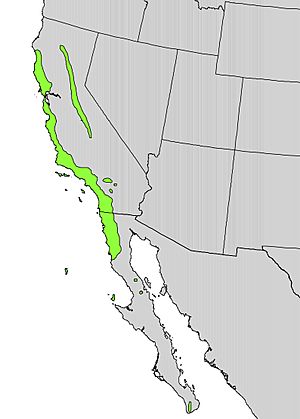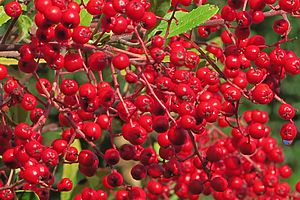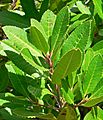Heteromeles facts for kids
Quick facts for kids Heteromeles |
|
|---|---|
 |
|
| Toyon bush in habitat | |
| Scientific classification | |
| Genus: |
Heteromeles
|
| Species: |
arbutifolia
|
 |
|
| Natural range | |
| Synonyms | |
|
|
The Toyon (scientific name: Heteromeles arbutifolia) is a common shrub found in parts of North America. It grows in places like Oregon, California, Baja California, and British Columbia. It's the only plant in its group, called Heteromeles.
People also call the toyon by other names, like Christmas berry or California holly. This is because its bright red berries look a lot like traditional Christmas decorations. Toyon plants are an important part of natural areas like chaparral and oak woodlands. They are very good at living in dry places.
Contents
What the Toyon Looks Like
Toyon plants usually grow to be about 2 to 5 meters (about 6 to 16 feet) tall. Sometimes, in shady spots, they can grow even taller, up to 10 meters (about 33 feet). They have a rounded or uneven shape.
Their leaves stay green all year round. They are about 5 to 10 centimeters (2 to 4 inches) long and have sharp, jagged edges. In early summer, the toyon plant grows many small, white flowers. These flowers are about 6 to 10 millimeters wide and grow in tight bunches. The most flowers appear in June.
After the flowers, the plant produces small, bright red fruits. These fruits are called pomes and are about 5 to 10 millimeters across. They look like berries. They grow in large numbers and ripen in the fall. They often stay on the plant through the winter, making the plant look very colorful.
Growing Toyon Plants
You can grow toyon plants in your garden if the soil drains well. They are popular as ornamental plants because of their pretty red berries in winter. They can even survive cold temperatures, down to about -12 degrees Celsius (10 degrees Fahrenheit).
Toyon plants don't need a lot of water. This makes them great for xeriscape gardening, which uses plants that need little water. They are also less likely to catch fire compared to some other plants in dry areas.
Many animals enjoy the toyon. Butterflies visit the flowers, and the fruit is a favorite food for many birds. These include mockingbirds, American robins, and cedar waxwings. Larger animals like coyotes and bears also eat the berries. When animals eat the berries, they help spread the toyon seeds to new places.
Traditional Uses of Toyon
Long ago, Native American tribes, like the Chumash and Tongva, used toyon berries for food. They would often dry the berries and store them. Later, they would cook them into a porridge or pancakes. Some people also made a jelly from the berries.
The Tongva people, who called the plant ashuwet, ate the berries fresh. They also boiled them, roasted them, or made them into a drink like cider. They used the crushed flowers to make a tea for certain health issues. For stomach aches, they made a tea from the bark and leaves. This same tea was also used as a general health tonic and to help with other body pains. They even used mashed ashuwet on sores to ease pain and washed infected wounds with a liquid made from the bark and leaves.
Is Toyon Safe to Eat?
Toyon berries can taste a bit sour and dry when they are raw. They contain a small amount of natural chemicals called cyanogenic glycosides. These chemicals can turn into a very small amount of hydrocyanic acid when digested. However, cooking the berries, even lightly, removes these chemicals. Many common fruits, like apples, apricots, and cherries, also contain similar natural compounds.
Some studies have shown that dried toyon berries can be safe to eat in small amounts. For example, a 2016 study found that 5 grams of dried berries were safe. This study also found no harmful cyanogenic compounds in the plant.
Laws About Toyon
In the 1920s, people in Los Angeles loved to collect toyon branches for Christmas decorations. It became so popular that the State of California passed a law. This law made it illegal to collect toyon branches from public land or land you don't own without written permission from the landowner.
On April 17, 2012, the city of Los Angeles officially made the toyon its native plant.
Images for kids
-
Plant fruiting on Mount Diablo, Contra Costa County, California.
See also
 In Spanish: Heteromeles arbutifolia para niños
In Spanish: Heteromeles arbutifolia para niños







